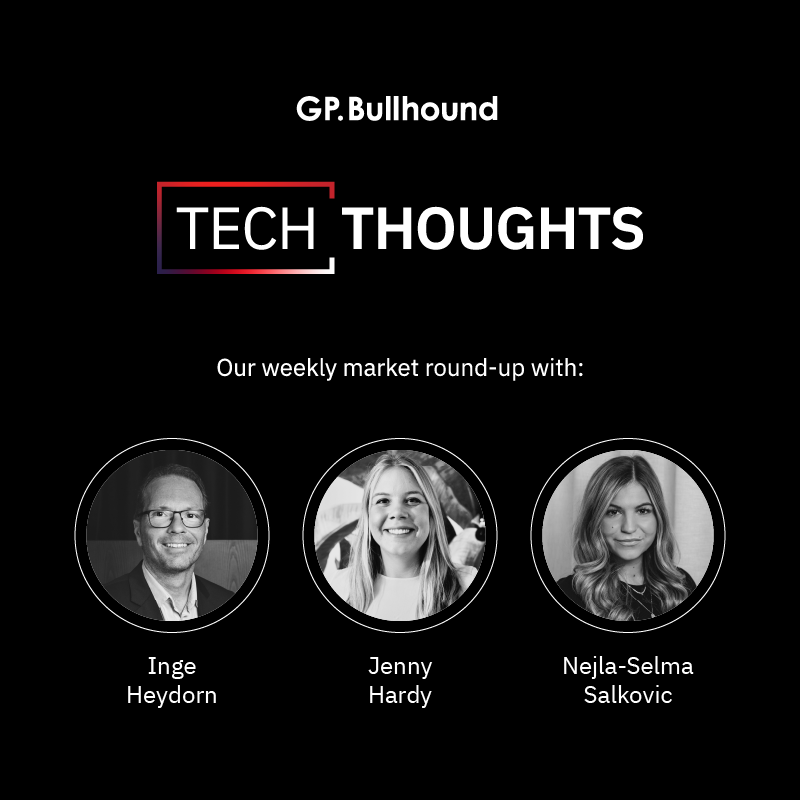Tech Thoughts Newsletter – 21 December 2022.

Despite market volatility, fundamental demand for technology has held up well in 2022, with the only real areas of weakness consumer tech (PC and smartphone) and crypto (a market which dominates the headlines but is really of little significance to wider tech).
Companies have continued to invest in software; semiconductors continue to be in high demand, and the offline to online shift has continued. That said, as we’ve gone through the year, and the macro outlook has deteriorated, there has clearly been increased scrutiny around investments, and, as the cost of capital has increased, we’ve seen higher hurdles for return on investment (ROI) and lengthening sales cycles.
We expect to see a similar trend in 2023. Consumers will see further pressure on their spending power with inflation still high, and unemployment likely to tick up. While areas like PCs and smartphones have already suffered a significant inventory correction (which we think will be worked through by Q1 or Q2), in a still weak consumer demand environment, the sector remains sensitive to supplier discipline. The reality is that we can go back into excess capacity with supply well above demand relatively easily. We therefore continue to be cautious.
Corporate spending is typically later cycle and while it has stayed at a high level in 2022, we expect to see continued scrutiny around deals and large-scale investment projects, with longer deal cycles and more focus on short-term ROI.
We expect spending around cost saving and efficiency projects to hold up well, likewise for those investments with a direct and measurable revenue payback. However, we do see some risk around timing and possible pushouts of projects. It’s not hard to imagine that this year CFOs and CEOs might prefer to wait for further clarity on how deep and long the downturn in the economy is before committing to large-scale spend. Those periods can be self-fulfilling to the extent they often lead competitors to do the same.
Our investment philosophy as a team is to focus on companies’ financial productivity and their ability to sustain that over a long period of time given competitive advantages. This in turn leads to a focus on cash flows and return on invested capital of the businesses we own, and their ability to compound those (through reinvestment) over time. Over the last several years of low rates and an effective free money environment, the market has tended not to focus on these fundamental outputs of companies, instead benefiting from low discount rates and multiple expansion. We believe this is changing, and that our focus on fundamental cash flows and returns in tech will lead us to companies whose share prices will outperform over a long period of time, particularly through a higher rates cycle.
Our portfolio going into 2023 focuses on companies whose products and services can help save costs or are necessary for their clients to drive their revenue going forwards. While we acknowledge both of these areas can still be pushed out, in most cases this can only be done for a limited time and most CEOs will acknowledge that doing so can inflict long term damage on competitive moats. We also note the relative robustness of technology cash flows and balance sheets in this vs. prior cycles. Pushouts of investment projects are likely to be a choice and not a necessity – again contributing to our view that any softness is likely to be a pause in spend rather than anything more meaningful.
We like software that has a high ROI for customers, like ServiceNow and Workday; semi capital equipment like ASML or KLA Tencor, whose customers need to invest to keep their technology leadership. We also like Infineon and NXP due to their exposure to power semiconductors within electric vehicles – one area where a secular shift is driving demand (and indeed where government mandates are driving that shift). Crucially, we think all of these businesses have competitive advantages – through IP, scale, network effects, customer relationships – that will allow them to sustain their financial productivity over time and generate significant cash flows into the future.
So there are certainly reasons to be optimistic in tech. That was reflected in a number of our holdings upgrading their future outlooks over the latest Q3 reporting season (when we were firmly in the midst of current macro concerns) – ASML and Infineon in semis, and ServiceNow, Workday and Palo Alto in the software space.
On to some more detailed sector thoughts:
Semis – close to the end of a big inventory correction in consumer but stay cautious and favour auto and industrial.
- As outlined above, while we’re seeing signs of light at the end of the tunnel in the consumer semis inventory correction (likely Q1 or Q2), the reality is that consumer exposed semis will still struggle to perform if consumer end demand remains weak. Consumer is an area particularly sensitive to supplier discipline, because so much consumer semi content is commoditised or fungible. There are times to be brave in consumer semis but we don’t think the time is right now and we remain cautious.
- On the positive side of semis we still see good signs in the auto semis space, where we see structural growth drivers around the move to electric vehicles and the associated content increase.
- 2022 was a year where several strong mandates around the transition to electric were put out by several governments around the world: California and Europe both announced they would ban combustion engine sales by 2035 and both Europe and the US are effectively requiring 50% share of vehicle production by 2030 to be EV..
- That will create some interesting dynamics around EV pricing for the auto OEMs (it will no longer be the case that you can stop production of your slow selling hatchback if it’s one of the ways of getting to your 50% target…).
- That’s one of the reasons we avoid owning any auto OEMs, Tesla being the one we’ve been asked most about this year. We think the barriers to entry in an EV world are even lower than the traditional combustion engine market, which has historically been a difficult industry in which to make a sustainably high return.
- But it will certainly be positive for the semi suppliers, where (unlike consumer) there are structural supply shortages around trailing edge nodes (more on that below), and where (unlike OEMs) they have sustainable competitive advantages around product IP, manufacturing and customer relationships.
Stocks – we continue to hold Infineon and NXP where we see their autos businesses remaining largely sold out into 2023. We continue not to hold any direct mobile/PC semis stocks (We do hold Apple which we consider to be a slightly different beast and which has so far shown itself to be pretty immune to consumer spending weakness).
Semicap equipment – we think China will keep spending up on trailing edge nodes.
- Tech sovereignty, structural shortages at trailing edge nodes, and a technology leadership race in logic all drove spending in the sector this year.
- The negative: Q2 saw cautiousness around memory spend (and indeed DRAM spot prices have been on a one way downward spiral for most of this year which is never a good backdrop for memory spend – and like the market we expect weakness in this area in 2023).
- However, we continue to expect to see investment projects at the leading edge driven by tech sovereignty and politics (TSMC in Arizona as the most recent example) and at the trailing edge (Infineon and TI) driven by structural shortages and high demand.
- Perhaps most significantly – and against what companies have indicated so far in 2022 – we expect to see China continuing to spend, despite US restrictions. We’ve seen that already with a number of cautious statements and outlooks around China investment being walked back by semicap equipment players.
- Our view is that it makes a lot of sense for China to try to build up a very strategic position in trailing edge semis (where they already have ~30% share). The reality is that there is a structural supply shortage in trailing edge globally; these trailing edge semis are critical (in autos, industrial) – that was clearly borne out by the shortage during the pandemic; and it is only really TSMC who have meaningful supply outside of China (Global Foundries is still relatively small in terms of capacity). It’s also an area the US has – and continues to – bizarrely ignore, after Intel sold off or reused most of its trailing edge fabs decades ago. China building up critical supply – which the US needs for products US consumers buy – would probably put them in a reasonably powerful negotiating position with the US…that might come in handy.
- While we acknowledge the possibility of 1-2 quarter logic project delays, we think this is largely priced into expectations. And remember, Intel has its Brookfield partnership, and for it, investing in the leading edge and trying to catch up its tech is frankly do or die. Samsung’s historic MO is to spend; TSMC could delay projects but Morris Chang has historically invested into downturns – that’s what he did in the GFC and that has effectively been what has enabled their current dominance.
Stocks – we own ASML, Applied Materials, KLA and LAM Research – which we view as the critical enablers of the semis industry.
Cloud and AI – public cloud growth to continue to moderate as optimisation of workloads continues, but this will be a pause, not a slowdown.
- The pandemic showed the benefits of scale and flexibility of cloud-based work processes and this will absolutely continue – and indeed the cost benefit of cloud will be a forceful driver of adoption in 2023 (moving to cloud can lead to savings of ~30% vs on prem). .
- While hyperscaler growth slowed through 2022, it continues to compound at high levels and the optimisation of workloads that was described by the big players is something we see as very healthy for the broader ecosystem.
- ChatGPT provided lots of entertainment with its debut a couple of weeks ago (we’d commented earlier in the year around China bringing out AI-based short form video and the implications of potentially unlimited supply of content – or content with zero incremental cost of production – on streaming).
- While the tech wasn’t new, the product went a long way in presenting the potentially far-reaching impact of AI to many different sectors.
- We promise we wrote this letter ourselves…
- Investment in cloud and AI continues apace for all the hyperscalers and for big tech more broadly (who we note as above are all in the very best of cash positions and all with a will to invest and stay ahead). Meta’s $35bn+ capex budget for 2023 was one of the standout numbers for us at Q3 results – that will be spent on datacentre servers and network infrastructure – CPUs, GPUs, memory.
- What’s more we think cloud will be a multi year refresh cycle – the energy cost of operating a below performance/watt server is high – that means companies will continue to invest around performance upgrades, which is positive for the whole semis ecosystem surrounding it.
Stocks – we own AMD which we think is continuing to extend its lead vs Intel, We own Microsoft, Amazon and Google in public cloud, and Cisco who is benefitting from the AI/ML network build.
Software – steady so far, but 2023 might test us
- While as we’ve noted software investment has remained steady (at high levels) in 2022, it will be no surprise to us to see incremental pressure on spend as we look ahead into 2023.
- Sales cycles in software are typically 6-12 months long which means anything we’re seeing in numbers now reflects sales conversations that started in Q1/Q2 2022 – when the world looked rather different. Those conversations got tougher in Q3/Q4 – we know that from company commentary, so we expect to see further pressure on numbers ahead.
- We think we’ll see more spend consolidation in software. It’s not hard to imagine budgets over the last several years have led to easy sign offs in software-land, and many companies will almost certainly have multiple vendors offering solutions to the same problems, or niche one product solutions that could be replaced by a broader product offering
- Remember Satya Nadella spent a good deal of Ignite this year talking about how much money “do more with less” his customers could save by bundling their solutions.
- At the same time software is clearly one of the ways companies can save cost through automation – 2022 was the year he also called software a deflationary force for businesses – in many ways tech is the solution to businesses’ cost issues and so inflation can mean demand for software and services solutions.
Stocks – we are positioned in those best-in-class software stocks which we think at the margin should benefit from consolidation of spend given their platform-like solutions: Microsoft, ServiceNow, Workday, Palo Alto.
Gaming – down but not out..
- It’s been a tough year for gaming – still coming off a COVID hangover – but for big titles, there have been some stellar sales numbers over the last month or so – Call of Duty $800m in 3 days, Nintendo 10m units in 3 days, Sony 5.1m in 5 days – all showing that the right titles can drive demand.
- Looking ahead to 2023 we think demand will continue to consolidate around bigger titles
- 2022 started with M&A in the space and TakeTwo’s acquisition of Zygna. This was followed very quickly by Microsoft’s announced acquisition of Activision. We expect the Activision/Microsoft deal to continue to create headlines but believe that if logic prevails the deal will go through (the arguments around competition make very little sense to us given the history of the industry, Sony’s exclusive games strategy, and the very early stage nature of the evolution towards streaming).
Stocks – we continue to want to own big franchise names in gaming which we think can be much more defensive in a weaker consumer environment and where incremental return on invested capital is high – Activision, Nintendo, Sony.
Advertising – a tough year, set to continue… ad spend will slow further and the mix shift will continue
- The writing was on the wall for digital advertising in 2022, but somehow it was even worse than anyone expected..
- TikTok competition (for eyeballs and dollars), Apple’s App Transparency, weaker macro all impacted, and within a largely auction based system, the pricing fell throughout the ecosystem very quickly.
- Cyclically, in 2023 digital advertising growth will slow; and new competition is taking engagement (and therefore spend) away from incumbent social platforms. Structurally, ATT is lowering returns of advertisers, and of the industry; and there will be a resulting mix shift towards more search-based/targeted media – including new areas of spend like retail media. This year’s GroupM ad report showed retail media spend at over 10% of total ad spend in 2022. Amazon disclosed its online advertising revenue for the first time in its full year results this year, showing $31bn revenue in 2021 and $10bn for Q4.
Stocks: In terms of broad portfolio exposure to digital advertising we own: Google, Amazon, Apple, Disney.
Streaming – price hikes and new advertising tiers was a positive, but lack of content spending discipline continues to hurt.
- We don’t know what Iger will do with his new mandate – streaming as an industry looks very different now vs. when he left Disney 3 years ago.
- We wrote at the time of results that we might prefer Disney to focus on its differentiated (predominantly Disney) content (or even taken the Sony approach and be a content seller) – but that is certainly not the path Iger set up for the business 3/4 years ago, nor the one we expect him to take now.
- Big tech are all competing meaningfully in the space; the COVID streaming boom has left us with more industry participants who might otherwise have chosen not to exist (Peacock, Acorn..); and the growth in the industry was largely pulled forwards through 2020/2021.
- Cash cow cable businesses will continue to see cord cutting accelerate, though they continue to be incentivised to spend on content (particularly in key areas like sports, which will keep content prices high) and because many of the cable players have built up streaming services as a fairly ineffective hedge.
- It wouldn’t surprise us if we see consolidation in the space – the economic incentive is clearly to amortise content over a bigger customer base. And the hope is clearly that eventually the number of players will go down and content cost inflation can abate.
- We’ll see in 2023 whether advertising comes good for Disney and Netflix (early rumours last week around Netflix’s ad launch were that they had missed viewer guarantees)
Stocks – we own Disney but trimmed on the last set of results. Broadly we question the long-term returns within the streaming sector – and for Disney wonder what Iger will do in terms of a strategy pivot. We also own Sony who are arguably the biggest winners in streaming by nature of it not having entered the race – with its Pictures business benefiting from the bidding war for content!
China – path out of COVID remains uncertain – limited exposure
- As we’re writing this the situation in China continues to deteriorate as it relates to COVID cases. It looks set to be a situation that will continue to have significant impacts across tech in 2023.
- We make no big predictions here – indeed our view on China has broadly been to expect the unexpected. It’s a market which remains very difficult to frame a downside around from an investment perspective.
Stocks – we don’t have any direct China/HK exposure, though clearly China is very important to many of the stocks we own both from a customer and supplier perspective. The one we’ve talked about most in this context is Apple. This year its China supply chain has turned from its biggest competitive advantage into arguably its biggest vulnerability and we expect it to continue to carefully (the interdependence of Apple/China is in very fine balance) build up alternative supply and assembly capability.

Learn more about our Tech Thoughts team here.
For a full overview of our 2023 Technology Predictions, please click here.
Enquiries
For enquiries, please contact:
Inge Heydorn, Partner, at inge.heydorn@gpbullhound.com
Jenny Hardy, Portfolio Manager, at jenny.hardy@gpbullhound.com
Nejla-Selma Salkovic, Analyst, at nejla-selma.salkovic@gpbullhound.com
About GP Bullhound
GP Bullhound is a leading technology advisory and investment firm, providing transaction advice and capital to the world’s best entrepreneurs and founders. Founded in 1999 in London and Menlo Park, the firm today has 12 offices spanning Europe, the US and Asia. For more information, please visit www.gpbullhound.com.



